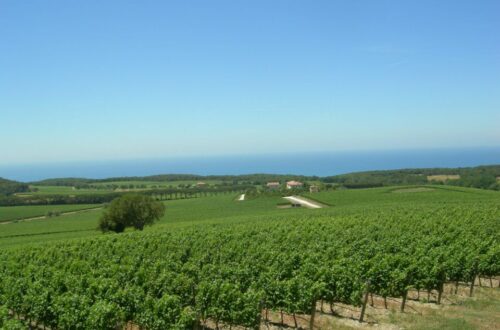Introduction
Freisa d’Asti DOC represents one of Italy’s most intriguing yet underappreciated red wines. This Piedmont native offers wine lovers a taste of authentic Italian terroir—combining centuries-old tradition with a modern revival. Whether you’re exploring Italian wine regions or seeking rare Italian wines to add to your cellar, Freisa d’Asti delivers elegance, history, and a dash of the unexpected.
Table of Contents
What is Freisa d’Asti DOC? (History & Origins)
Recognized as a DOC in 1972, Freisa d’Asti is made predominantly from the Freisa grape, a close genetic relative of Nebbiolo. Historical records of Freisa date back to 1517, and by the 18th century it was among Piedmont’s most celebrated black grapes. Once covering a third of the vineyards in Asti and Alessandria, its popularity waned in the 20th century—until today’s producers began restoring it as a symbol of Piedmont’s wine heritage.
Freisa d’Asti Wine Regions & Terroir
The DOC production zone spans the rolling Monferrato hills northeast of Asti, where vineyards sit at 200–400 meters above sea level. Soils here are a mix of clay-limestone and Astian sand, rich in marine fossils, giving the wine its aromatic lift and structural balance. Key villages include Canelli, Bubbio, Nizza Monferrato, and Castel Boglione.
[Internal link suggestion: Link “Monferrato” to your Monferrato wine guide; Link “Piedmont” to your main Piedmont wine region article]
Freisa Grape Characteristics & Winemaking
Freisa is a robust, late-ripening variety prized for its tannic structure and aromatic intensity. The DOC permits Rosso, Superiore, and Spumante (sparkling) styles, with the following regulations:
| Style | Minimum Alcohol | Aging Requirements |
| Rosso | 11.5% | None |
| Superiore | 12.5% | 1 year (6 months in wood) |
| Spumante | 11% | None; bottle or tank fermented |
Winemaking styles vary from light, fruity frizzante to structured, oak-aged bottlings designed for cellaring.
[External link suggestion: Link “Freisa grape” to the Italian Wine Central Freisa page]
Freisa d’Asti Tasting Notes & Wine Styles
Appearance: Ruby to cherry red, garnet with age.
Aromas: Fresh raspberries, wild strawberries, violet, rose petal, and subtle spice.
Palate: Bright acidity, medium to full tannins, flavors of red fruit, herbs, and sometimes earthy or chocolatey depth in aged versions.
Styles:
- Rosso: Fresh, fruity, everyday drinker.
- Superiore: More structured, age-worthy.
- Spumante: Joyful, lightly sparkling, ideal as an aperitivo.
Best Food Pairings for Freisa d’Asti
| Dish Type | Pairing Example |
| Piedmont pasta | Tajarin with meat ragù |
| Game & roasts | Braised rabbit, roast lamb |
| Cheese | Castelmagno, Bra DOP, Toma Piemontese |
| Antipasti | Coppa, Asti salami, pancetta |
Serve still versions at 16–18°C and sparkling at 8–10°C. Use a tulip-shaped glass to capture its floral aromatics.
[Internal link suggestion: Link “Piedmont pasta” to your Italian food pairing guide]
Where to Buy Freisa d’Asti Wine (Pricing Guide)
Freisa d’Asti remains a boutique wine, often found through specialty importers:
- La Miraja Freisa d’Asti 2022 – $26
- Ca’ Del Prete “Blenda” 2022 – $37 (organic, no added sulfites)
- Laiolo Reginin Setfii 2020 – €14
Expect to pay $20–$40 for quality examples.
[External link suggestion: Link to Wine-Searcher Freisa d’Asti listings]
Freisa d’Asti vs Other Italian Red Wines
Compared to Barolo (Nebbiolo-based), Freisa is lighter, fruitier, and more playful—though its tannins can rival the big names. Unlike Chianti Classico, which leans cherry and herbal, Freisa delivers strawberry-rose charm with Piedmontese grit. For lovers of rare Italian wines, it’s an ideal conversation starter.
Vintage Guide & Aging Potential
- Young (1–3 years): Fruity, vibrant, perfect for frizzante styles.
- Mid-age (4–6 years): Superiore develops spice, floral, and earthy depth.
- Longer aging (7–10 years): Reserved for top vintages, tannins mellow, flavors harmonize.
Producer Profiles
- La Miraja – Small historic estate producing expressive, traditional Freisa.
- Ca’ del Prete – Organic pioneer with pure-fruit expressions.
- Laiolo Reginin – Focused on terroir-driven, long-maceration styles.
Wine Tourism & Cultural Experiences
Freisa d’Asti’s DOC zone is ideal for a Monferrato wine weekend—visiting historic cellars, pairing tastings with local truffle dishes, and exploring UNESCO-protected vineyard landscapes.
[Internal link suggestion: Link to your “Wine Tourism in Piedmont” article]
Frequently Asked Questions
What is Freisa d’Asti?
A DOC red wine from Piedmont made primarily from the Freisa grape, known for its bright red fruit, floral aromas, and versatile styles.
Is Freisa related to Nebbiolo?
Yes—it shares a parent-offspring relationship, explaining its tannic structure.
Can Freisa d’Asti be sparkling?
Yes—Spumante and Frizzante versions exist, both tank- and bottle-fermented.
Fun Facts & Cultural Notes
- Mentioned by Hemingway in A Farewell to Arms.
- Once taxed at double the rate of common wine in the 1700s.
- Name possibly derives from fresia, meaning strawberry.
Call to Action
Love discovering rare Italian wines? Join the Drink Italian newsletter for exclusive producer interviews, tasting guides, and event invitations straight from the heart of Italy’s wine country.


